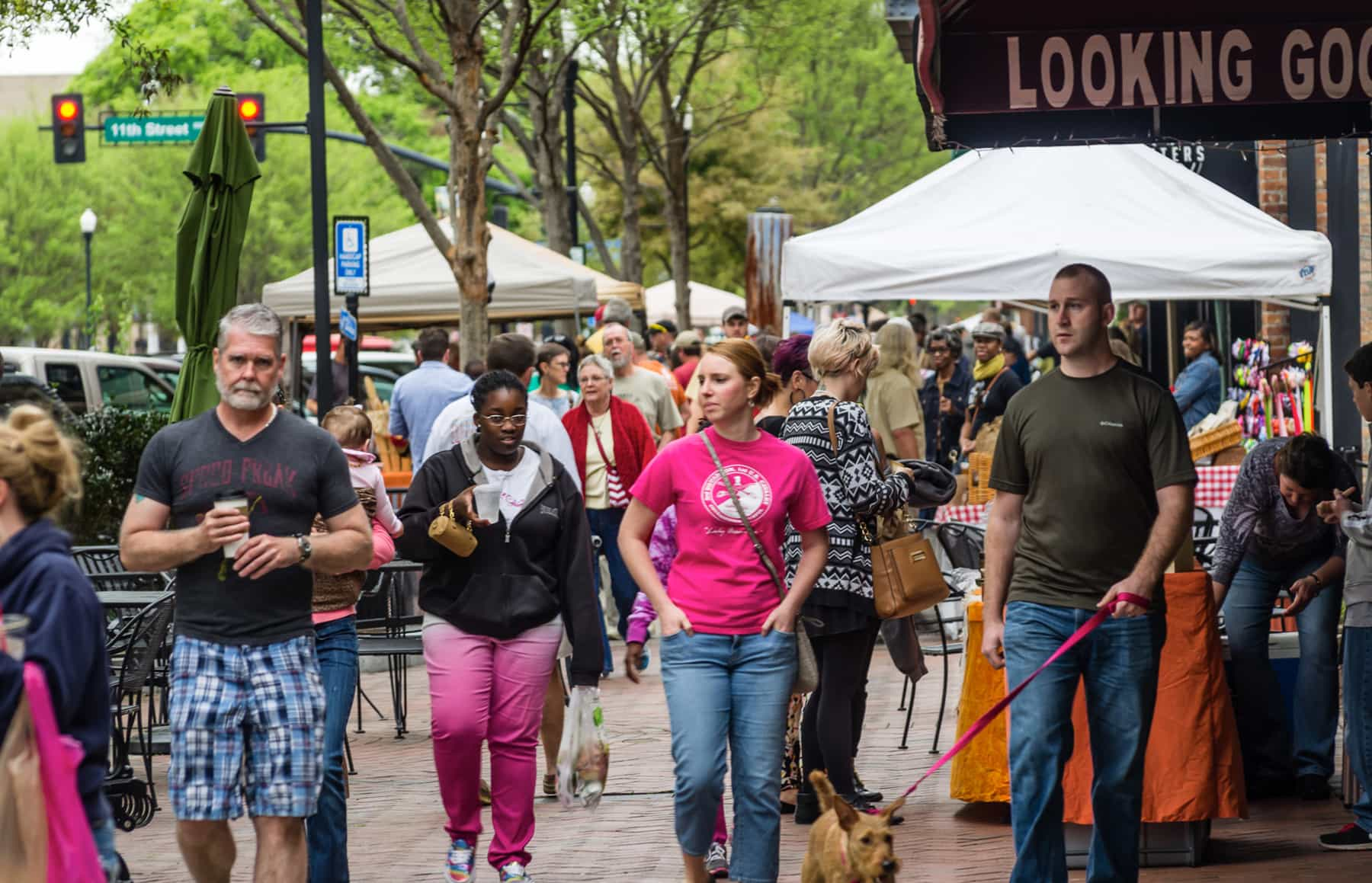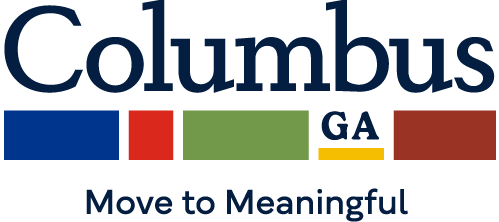
Neighborhoods.
The area boasts diverse housing options from historic homes to walkable family neighborhoods to riverfront apartments to lakefront gated communities. Access to an area like this usually comes with a steep price tag, but here, affordable housing makes your dream home a reality. Best of all, the cost of living and commute time are well below the national average. Both historic and progressive, this unique region has somewhere amazing for everyone to live.
Neighborhoods
East Columbus
Roughly bounded by Macon Road to the north, St. Mary’s Road to the south, Fort Moore to the east, and I-185 to the west, this area is largely residential with affordable homes in newly developed, and well-established neighborhoods. East Columbus gives residents access to multiple community centers, local eateries, grocery stores, and schools.
Fort Moore
Fort Moore residents have the benefit of quick and easy access to and from work, shopping, dining and entertainment, such as a movie theater, bowling, an internet cafe, and video game lounge. National chains such as Starbucks, Domino’s, Boston Market and Zaxby’s are located in and around neighborhoods, as well as several gas stations, convenience stores, and fast-food restaurants.
The Commissary and Main Exchange are located close to the new Martin Army Community Hospital, a state-of-the-art full-service medical center, housing all family and specialty clinics, pharmacy, and a 24/7 emergency room. Families have access to NAEYC-accredited child care and DoDEA schools (four elementary and one middle school). Welcome home.
Learn More at https://www.army.mil/qualityoflife/
Fort Mitchell
8 miles south of Phenix City you’ll discover Fort Mitchell, a family-friendly community consisting predominantly of military families. The area is home of Fort Mitchell Historic Site, a park and archaeological site that was declared a National Historic Landmark in 1990. Fort Mitchell National Cemetery serves as the final resting place of approximately 5,000 U.S. military veterans, including victims of WWI and Desert Storm. Nearby, the Chattahoochee Indian Heritage Center celebrates the culture of native people who inhabited the Chattahoochee Valley.
Harris County
Just north of Muscogee County, Harris County is a unique, and picturesque place to live, perfect for those seeking refuge from the bustling city life. Only minutes away from many adjacent cities, the back roads and scenery provide an almost majestic experience for all. And, families love raising their children in a rural atmosphere where their activities find natural settings as their playground.
Liberty District
Originally settled in the 1830s and 1840s by freedmen, the Liberty Heritage Historic District contains indigenous architectural styles that have survived within the context of the community that created them. It is possible to document the architectural contributions of local African American builders and craftsmen in this district, which is bound by 3rd and 6th Avenues south of 8th Street and between 5th and 6th Avenues south of 11th Street.
Following the Civil War, many freed slaves located to the district, making up the majority of the population during the 1870s. Various businesses, new construction, and the arts thrived here from the turn of the 20th century to the beginning of World War II.
The Liberty Theatre, c. 1924, was a venue for movies, social gatherings, and a stop for musicians, singers, performers, and lecturers. Other significant sites in the district include the home of Gertrude “Ma” Rainey Pridgett, a nationally known gospel and blues performer in the 1920s who was called “The Mother of the Blues,” and church buildings such as First African Baptist. All three buildings are listed on the National Register of Historic Places.
This neighborhood is home to Columbus’ first local brewery, Chattabrewchee, Goldens’ Foundry, Aspirion, Scofflaw, Moe’s Barbecue and more locally owned businesses. Options for living include homes for purchase and rental, apartments, and lofts.
Midland
This community is situated east of Columbus and is an easy commute to Fort Moore. Midland, Georgia provides a rural lifestyle close to city amenities. The most recent development, Lakeside Village is home to several fast-casual and full-service restaurants. Midland Commons is a mixeduse development that will bring residential, retail, and restaurants. Midland is a nice mix of subdivisions and large land plot residences.
MidTown
Tree-lined streets meander through antebellum estates in MidTown, a diverse area of town featuring six National Register Historic Districts, quaint parks, museums, and the Columbus Public Library. MidTown is also home to the International headquarters of Aflac, Rainey-McCullers School of the Arts, The Columbus Museum, and Columbus’s most visited park, Lakebottom Park. MidTown, Inc. is a local organization that works to grow and strengthen the MidTown business community, enhance the environment, and create a more walkable, bikeable streetscape.
Mill District
The Mill District encompasses four historic neighborhoods: City Village, North Highland, Bibb City, and Anderson Village. This area is an important part of our economic history as Columbus was founded on the commodity of cotton, and textile production. It served as the residential neighborhood for generations of families that worked in the area’s textile mills.
Formerly an incorporated city surrounding and managed by the Bibb Manufacturing Company, Bibb City is today widely recognized and has a unique community identity. Two years after the mill closed in 2006, Bibb City was nominated for the National Register of Historic Places by the State Historic Preservation Office. In 2010, the national designation was approved and the Bibb City Historic District was listed in the National Register of Historic Places. The centerpiece of the community was a 750,000 sq. ft. textile mill, which at its peak, employed 2,500 workers and stood as the nation’s largest cotton mill.
The City Mills buildings are located on the site of Columbus’s oldest manufacturing operation (est. 1828) on the Chattahoochee River. The surrounding houses, making up the City Village neighborhood were built as supportive mill worker housing. On the east side of 2nd Avenue are the North Highlands, and Anderson Village neighborhoods. Predominantly made up of small early 20th-century wood-framed homes, the North Highlands community provided workforce housing for the two aforementioned mills, but also the Swift Mill (Gildan), Anderson/Meritas Mill (Highland Terrace), and Columbus Manufacturing Company (Johnston Mill Lofts).
Anderson Village is the most contemporary housing development of the four neighborhoods. Made up primarily of small brick cottages with small front porches, the homes of Anderson Village were built in response to the housing demands of post-WWII settlement. The tiny (750 sq. ft.) brick homes were affordable and located to make walking to work (the mills) easy. All four neighborhoods are beginning to see a renewed interest by investors as they offer prospective buyers affordability and access to Uptown Columbus amenities.
North Columbus
The most recent development in Columbus, this district is home to established neighborhoods, public and private schools, national retailers, restaurants, and two AMC movie theaters. North Columbus is home to The Hughston Clinic, a world-renowned sports medicine facility, and the location of Standing Boy Creek Wildlife Management Area—nationally recognized for its mountain biking trails. Residents can find homes ranging in all prices within neighborhoods of all shapes and sizes.
Within the North Columbus area, you’ll find Old Town — a charming 300-acre mixed-use development that was named Southern Living® Inspired community of the year in 2016. Old Town is a place where the best things in life occur outside, on front porches, in tree swings. Where southern charm and hospitality meet the modern conveniences of today.
Original Historic District
The Columbus Historic District is primarily a residential area that includes schools, churches, stores, and industrial buildings. The boundaries are roughly the Chattahoochee River to the west, 9th Street to the north, the block between 3rd and 4th Streets to the east, and 4th Street to the south. The district was listed in the National Register of Historic Places and designated as a local historic district in 1969. The economic diversity of the area is illustrated through the variety and sizes of homes that include Greek Revival, Georgian, Late Victorian, Late 19th and 20th Century Revivals, as well as Mid 19th Century Revivals. The smaller, more indigenous examples such as the vernacular “shotgun” tend to be located in the eastern section of the district, while the largest homes are found along Broadway. This neighborhood is a few short blocks from Uptown Columbus and contains multiple free playgrounds and parks. Options for living include apartments and homes for purchase and rent.
Phenix City
Just across the Chattahoochee River, and still in the Eastern time zone, is the easternmost point of Alabama: Phenix City. The area is filled with some of the Southeast’s richest history, with diverse recreation opportunities, facilities, and amenities to suit any outdoor, or indoor desire.
Phenix City prides itself in its exemplary public, and private school systems (including a NASA Explorers Elementary), state-of-the-art orthopedic and rehabilitation hospitals, and an abundance of affordable housing opportunities.
Seale, AL
Seale is a rural community with a strong military presence; home to historic landmarks, beautifully-restored antebellum buidlings and one of the state’s oldest buildings: the Russell County Courthouse. Speed lovers can get their fix at the East Al Motor Speedway, watching drivers showcase their skills on the high-banked clay track. The area is also home to a wealth of local art, antiques and curios at two popular attractions founded by Alabama artist Butch Anthony: the Museum of Wonder and the Drive through museum. Popular annual events include the Russell County Stampede Rodeo and the Labor Day Fair.
South Columbus
This district has a rich history in military housing, situated between downtown Columbus and Fort Moore. South Columbus is home to the National Infantry Museum—dedicated to the infantry forces in the U.S. Army, Oxbow Meadows, a popular park with various walking trails, a learning center with animal and insect displays, and the nine-hole Oxbow Creek Golf Course. Here you’ll find the Columbus Civic Center, the Columbus South Commons (home of the 1996 Olympic Softball Competition), Golden Park, Columbus Ice Rink and the world-famous creators of Twinkies and Ding-Dongs—Hostess. South Columbus is also abundant in ethnic dining experiences, from Mexican and Korean, to Caribbean and German.
Uptown
“Uptown” is what Columbus calls its downtown, and it’s the central business district complete with museums, hotels, historic landmarks such as The Springer Opera House—Georgia’s state theater, and locally owned and operated restaurants. Uptown is home to RushSouth, a multi-use whitewater park featuring the world’s longest urban whitewater course and high-speed zip lines that cross the Chattahoochee River from Georgia to Alabama and back. Residents can choose between lofts, condominiums and luxury apartments. This area is for residents looking for high walkability.

